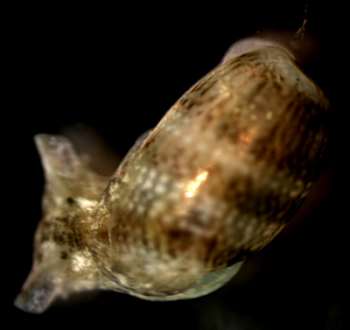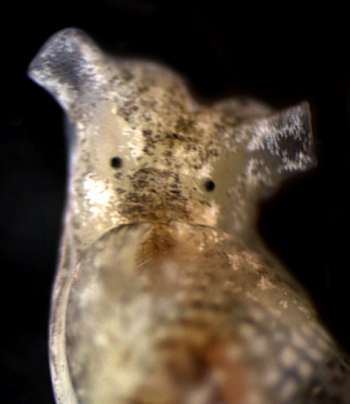Haminoea succinea? from Florida
December 10, 2003
From: Steve Massey and Julie Schwartz


Dear Bill
We obtained what we think is a shelled slug from Tarpon Springs in Florida in September, which came into our lab on Penicillus algae. The habitat was shallow flats, some mangroves present, with large amounts of Penicillus growing. We are not sure if it is a sacoglossan (ie Volvatella) or a cephalaspidean. The shell is pliable ('bendy') and indented at the end furthest from the head. The animal is small, approx 4 mm in length. The rhinophores are short and blunt, and the head displays black and white pigmented cells. It is unclear whether the animal feeds on the Penicillus. Any help you can provide with identification will be much appreciated.
Best wishes
Steve Massey and Julie Schwartz
semassey@chuma1.cas.usf.edu
Massey, S. & Schwartz, J., 2003 (Dec 10) Haminoea succinea? from Florida. [Message in] Sea Slug Forum. Australian Museum, Sydney. Available from http://www.seaslugforum.net/find/11608Dear Steve & Julie,
I am pretty sure this is a species of Haminoea. They are herbivores so it is possible they are feeding on Penicillus. However we really don't know how specialised their food choice is so they may feed on a variety of algae, though most likely they are restricted to greens. Some species, when nothing else is around, can feed on the diatomaceous algal film found covering most surfaces in shelterd waters such as mangrove swamps.
It is posssible that your species is Haminoea succinea (Conrad, 1846), which is a species known from Maryland, Florida, Texas, and parts of the Caribbean. Most species of Haminoea have a shell which is quite rounded in appearance, whereas in H. succinea the sides of the shell are nearly straight giving the shell a cylindrical rather than 'bubble' shape. One problem is that 'bubble-shells' have been described essentially from their shells so it is difficult to be sure when you have a live animal. The shell of H. succinea grows to about 10mm, so if your animals were only 4mm long then it is most likely they are very juvenile individuals, which makes identification even more difficult.
Hopefully someone with local knowledge can give us their opinion.
• Marcus, Ev. (1972) Notes on some opisthobranch gastropods from the Chesapeake Bay. Chesapeake Science, 13(4): 300-317.
• Conrad, T.A. (1846) Proceedings of the Acadmey of Natural Sciences, Philadelphia, 3(1): 26
Best wishes
Bill Rudman
Related messages
-
Opisthobranch from Veracruz, Mexico
From: Rodrigo J. Pérez Weil, September 3, 2008 -
Opisthobranch from Yucatan, Mexico
From: Jazmin Ortigosa, November 6, 2007 -
Re: Pauleo jubatus? from St. Vincent Islands?
From: Philip Cromwell, December 14, 2005 -
Pauleo jubatus? from St. Vincent Islands?
From: Les Wilk, December 12, 2005 -
Flabellina sp. from St. Vincent
From: Les Wilk, December 2, 2005 -
Unknown dorid from the Caribbean
From: Sean Kearney, July 19, 2005 -
Aeolid from Florida
From: Kelly Kingon, January 28, 2005 -
Re: Okenia? from Gulf of Mexico
From: Juan Lucas Cervera, February 19, 2004 -
Okenia? from Gulf of Mexico
From: Kelly Hooper, February 14, 2004 -
Corambe? from the Bahamas
From: Colin Redfern, October 15, 2003 -
Corambe? from Jamaica
From: Ross W. Gundersen, October 13, 2003 -
Colorful aeolid from Florida
From: Linda Ianniello, April 10, 2003 -
Caribbean Cuthona?
From: Dave Behrens, October 2, 2002 -
Aplysia sp. from the Colombian Caribbean
From: Nestor E. Ardila E., July 5, 2002 -
Dendronotus sp.? from Colombia
From: Alexander Taborda M., June 18, 2002 -
Unknown Caribbean Polycera
From: Dave Behrens, May 1, 2002 -
Aeolid from from the Dominican Republic
From: Elianny Domínguez Tejo, June 18, 2001 -
An aeolid from Colombia
From: Phanor Montoya, January 5, 2001
